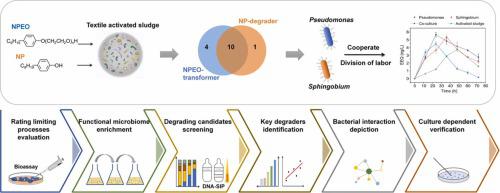Journal of Hazardous Materials ( IF 12.2 ) Pub Date : 2023-05-30 , DOI: 10.1016/j.jhazmat.2023.131740 Xiwei He 1 , Bingwei Yan 1 , Jinhong Jiang 1 , Yixin Ouyang 1 , Depeng Wang 1 , Peng Liu 1 , Xu-Xiang Zhang 1

|
Efficient management of disguised toxic pollutants (DTPs), which can undergo microbial degradation and convert into more toxic substances, necessitates the collaboration of diverse microbial populations in wastewater treatment plants. However, the identification of key bacterial degraders capable of controlling the toxicity risks of DTPs through division of labor mechanisms in activated sludge microbiomes has received limited attention. In this study, we investigated the key degraders capable of controlling the risk of estrogenicity associated with nonylphenol ethoxylate (NPEO), a representative DTP, in textile activated sludge microbiomes. The results of our batch experiments revealed that the transformation of NPEO into NP and subsequent NP degradation were the rate-limiting processes for controlling the risk of estrogenicity, resulting in an inverted V-shaped curve of estrogenicity in water samples during the biodegradation of NPEO by textile activated sludge. By utilizing enrichment sludge microbiomes treated with NPEO or NP as the sole carbon and energy source, a total of 15 bacterial degraders, including Sphingbium, Pseudomonas, Dokdonella, Comamonas, and Hyphomicrobium, were identified as capable of participating in these processes, Among them, Sphingobium and Pseudomonas were the two key degraders that could cooperatively interact in the degradation of NPEO with division of labor mechanisms. Co-culturing Sphingobium and Pseudomonas isolates exhibited a synergistic effect in degrading NPEO and reducing estrogenicity. Our study underscores the potential of the identified functional bacteria for controlling estrogenicity associated with NPEO and provides a methodological framework for identifying key cooperators engaged in labor division, contributing to the management of risks associated with DTPs by leveraging intrinsic microbial metabolic interactions.
中文翻译:

通过活性污泥微生物组分工机制识别控制伪装有毒污染物毒性风险的关键降解剂:以壬基酚聚氧乙烯醚为例
伪装有毒污染物 (DTP) 会被微生物降解并转化为毒性更强的物质,因此有效管理需要污水处理厂中不同微生物种群的协作。然而,通过活性污泥微生物组中的分工机制识别能够控制 DTP 毒性风险的关键细菌降解剂受到的关注有限。在这项研究中,我们研究了能够控制纺织活性污泥微生物组中与壬基酚乙氧基化物(NPEO)(一种代表性 DTP)相关的雌激素风险的关键降解剂。我们的批量实验结果表明,NPEO转化为NP以及随后的NP降解是控制雌激素风险的限速过程,导致NPEO生物降解过程中水样中雌激素的倒V形曲线纺织活性污泥。通过利用以NPEO或NP作为唯一碳源和能源处理的富集污泥微生物组,共鉴定出15种细菌降解菌能够参与这些过程,包括Sphingbium、Pseudomonas、Dokdonella、Comamonas和Hyphomicrobium ,其中,鞘氨醇和假单胞菌是两种关键的降解菌,它们可以通过分工机制协同相互作用降解 NPEO。共培养鞘氨醇和假单胞菌分离株在降解 NPEO 和降低雌激素方面表现出协同作用。我们的研究强调了已识别的功能性细菌在控制与 NPEO 相关的雌激素方面的潜力,并提供了一个方法框架来识别参与分工的关键合作者,通过利用内在的微生物代谢相互作用,有助于管理与 DTP 相关的风险。











































 京公网安备 11010802027423号
京公网安备 11010802027423号